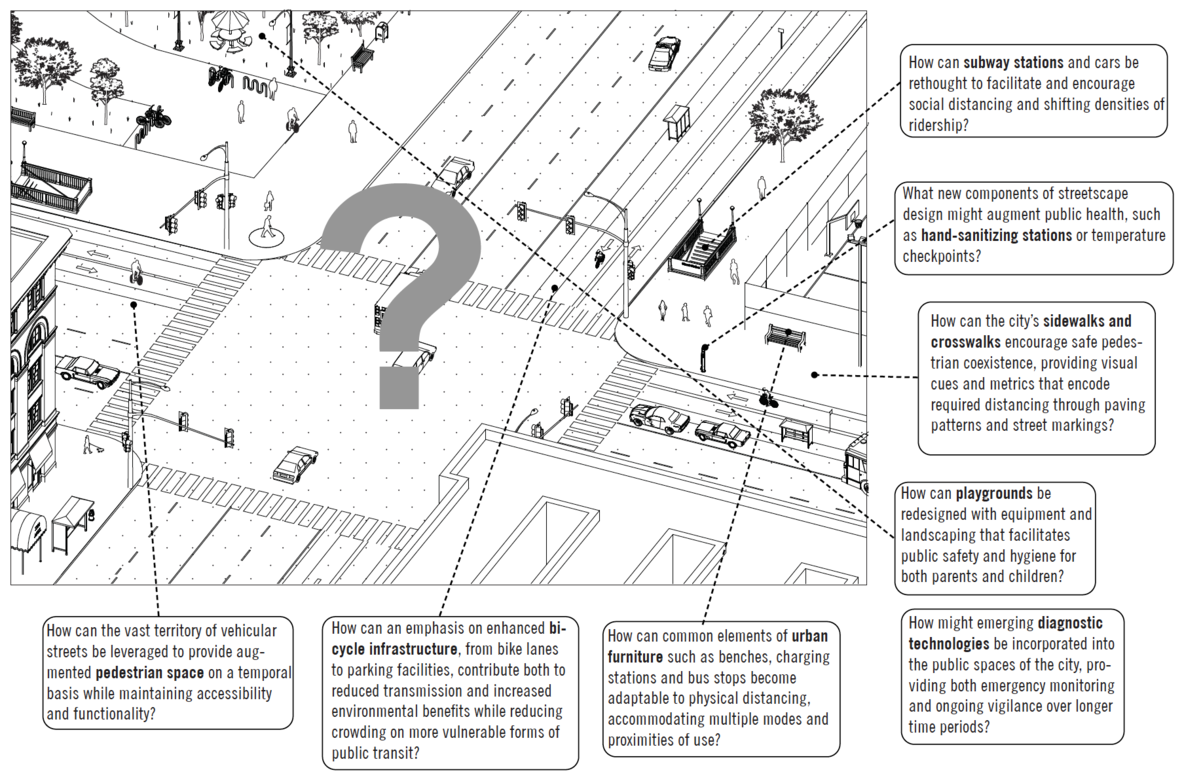Lewis and Nordenson's "Manual of Urban Distance" Awarded in Princeton Half Million Dollar Funding Program for Actionable COVID-19 Research Projects
April 10, 2020
Professor Paul Lewis and Professor Guy Nordenson's "Manual of Urban Distance: Strategies for Reconfiguring the City" has been selected for the Princeton University Funding Program for Rapid, Novel and Actionable COVID-19 Research Projects. They are one of seven teams awarded up to $100,000 for faculty-led research projects with the aim of accelerating solutions to the challenges of the COVID-19 pandemic. Lewis and Nordenson's research will address the challenges of physical distancing in urban settings and explore strategies that minimize the effects of potential resurgences of COVID-19 and other future pandemics.
Physical distancing is instrumental in slowing the transmission of COVID-19. Lewis and Nordenson's proposal focuses on the fact that distancing has been especially crucial in the dense urban environments of cities as the rate of infection in the world’s cities greatly outpaces that of suburban or rural areas. The density of the city, which has historically been considered its greatest asset, economically, socially and environmentally, is now precisely at odds with the realities of a pandemic, and has become a crippling vulnerability.
While recommendations given by the government and the medical community have been behavioral in nature, Lewis and Nordenson are proposing that these recommendations have the potential to be translated and built into the context of the city through a manual or toolkit of design analyses and spatial propositions. Design strategies addressing collective spaces such as public transportation, the streetscape, and parks have the potential to recalibrate the city in order to better negotiate the incompatibility between the functional density of urban spaces and the protection of the health, safety and welfare of the public in the face of communicable disease, and be leverage toward a more ecologically viable city. Underscoring the urgency of this proposal is the concern that the long term consequences of the global coronavirus pandemic is equating cities with fear, and triggering a future collapse of urban life and culture. It is essential to provide clear solutions to change spatial practices as a means of controlling the spread of the virus while reinforcing the image of the city as spaces of vibrant and manageable collective public life.
Lewis and Nordenson will begin by analyzing how recent spatial practices in denser cities, like Hong Kong, Taipei and Seoul, have resulted in lower infection rates. They will analyze the emerging models, and propose new strategies which do not simply mitigate spread of disease but which also sustain and enhance the very aspects of the city that we value—diversity, vibrancy, and communication. By working in tandem with ideas put forward through ecologically beneficial spatial approaches, they believe that urban life can be enriched precisely by engaging multiple aspects of environmental change and crises, of which pandemics are only one.
New York City is the early epicenter of the outbreak in the United States, and as such, is well situated to serve as a case study for this research. While tactics will be explored for the specific conditions of New York and tailored to its agencies, spatial conditions and stakeholders, it is anticipated that the developed design manual / visual toolkit will be adopted and deployed by urban areas whose outbreaks are peaking later. The area of investigation will be the public spaces of the city with particular focus on transit systems (subway, buses, bicycle infrastructure), streetscapes (sidewalks, plazas) and parks (recreation areas, promenades, playgrounds).
The research will be conducted in two phases, roughly aligning with the anticipated timeline of COVID-19 and the lifting of mandated stay-at-home orders, as it is understood at this point in the crisis. At the end of each phase, the project team will produce a manual of strategies corresponding to the particular intensity and challenges of that phase. This manual will be published online to provide a visually accessible and legible resource and guide to politicians, policy makers, public agencies and planners within New York, in the country and across the globe.
For more information about Princeton University's funding of COVID-19 research projects:
Princeton awards over half-a-million dollars in funding for rapid, novel and actionable COVID-19 research projects, by Catherine Zandonella, Office of the Dean for Research, April 10, 2020
The Daily Princetonian, Seven COVID-19 research projects receive over $500,000 in funding from U., by Albert Jiang, April 13, 2020


